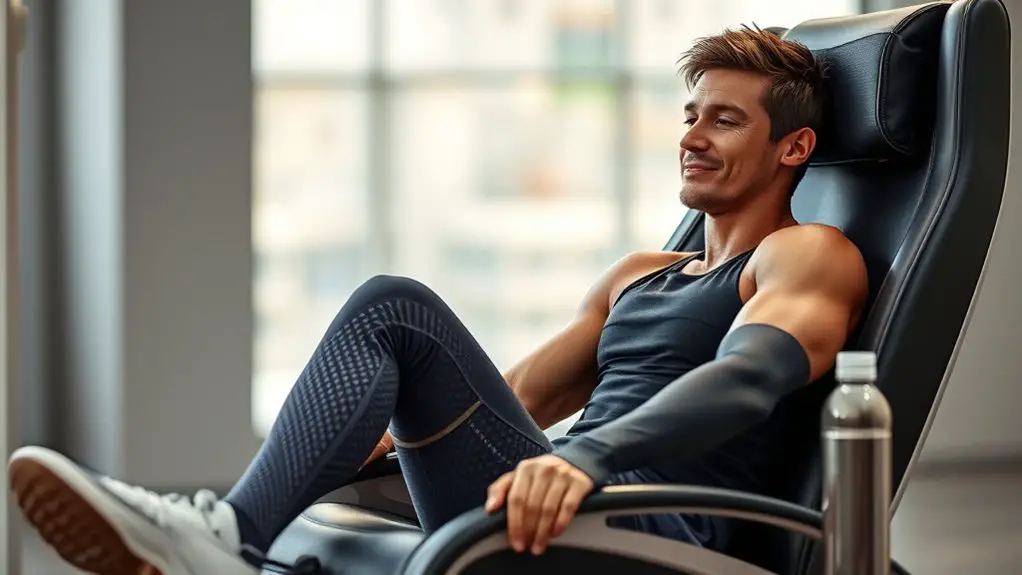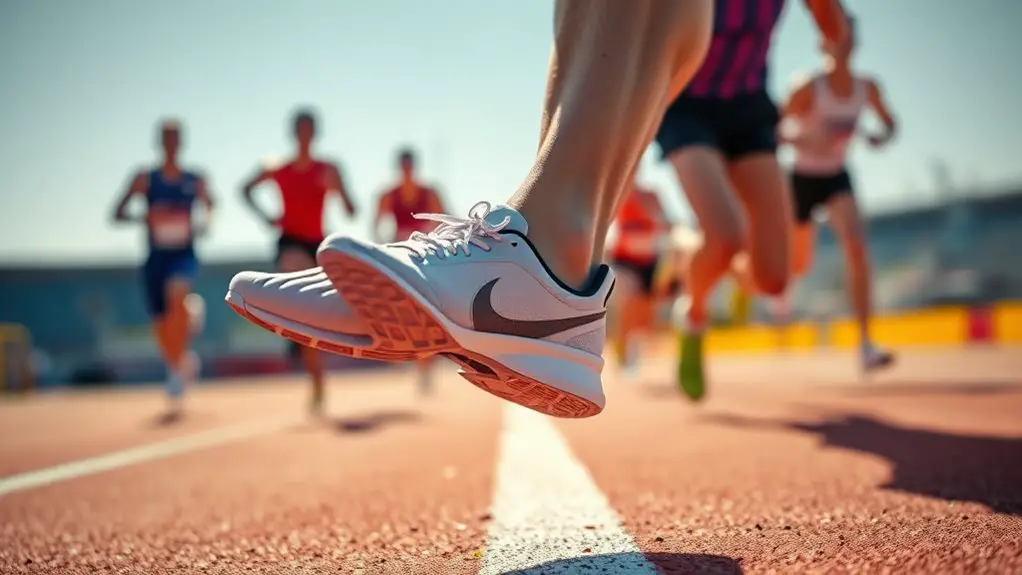Compression therapy works for sports recovery by enhancing blood circulation, which delivers oxygen and nutrients while removing metabolic waste. This process reduces muscle soreness and fatigue, allowing for quicker recovery and less discomfort post-workout. You'll feel more energized and ready for your next training session. Additionally, it can boost your mental state, leaving you feeling more confident and agile. If you're curious about the different types of compression garments and their benefits, there's more to explore.
The Mechanism of Compression Therapy
When you engage in intense physical activity, your muscles can experience swelling and fatigue, which is where compression therapy comes into play. This therapy involves applying pressure to your limbs, aiding in muscle recovery. By using compression garments, you help support your muscles and reduce that uncomfortable swelling. The pressure encourages fluid movement, preventing excess buildup in your tissues. It also helps your body clear out metabolic waste, allowing you to feel lighter and more energized. You'll notice that as your muscles recover quicker, you gain the freedom to push your limits. With consistent use of compression therapy, you can embrace your active lifestyle without the burden of soreness, letting you enjoy every moment of your physical pursuits.
Benefits of Enhanced Blood Circulation
Enhanced blood circulation is essential for ideal recovery after intense workouts, as it guarantees that oxygen and nutrients reach your muscles more efficiently. When you engage in compression therapy, your blood flow improves, helping to flush out toxins and supporting the healing process. This means you can feel rejuvenated and ready for your next adventure sooner. With better circulation, your body can repair itself effectively, allowing you to maintain your freedom in movement and activity. You'll notice that your energy levels rise, and you can tackle your next challenge with gusto. Embracing enhanced blood circulation through compression therapy can truly empower your recovery journey, enabling you to enjoy your passion for sports without unnecessary delays.
Reduction of Muscle Soreness and Fatigue
While you push your limits during training, muscle soreness and fatigue can often follow, making recovery feel like a challenging task. Compression therapy can be your secret weapon against that discomfort. By applying consistent pressure, it helps reduce swelling and promotes quicker recovery, allowing you to bounce back faster. You'll notice that those post-workout aches diminish, letting you maintain your freedom to train hard without the nagging pain holding you back. Plus, with less fatigue, you're more energized and ready to embrace your next workout. Imagine reclaiming those days when you feel light and agile again. So, slip on those compression garments and feel the difference as you conquer your fitness goals with renewed vigor and resilience.
Acceleration of Metabolic Waste Removal
As you push through intense workouts, your body accumulates metabolic waste products that can hinder recovery. Compression therapy accelerates the removal of these wastes, helping you feel lighter and more energized. By applying pressure to your muscles, it enhances blood flow, enabling faster elimination of lactic acid and other byproducts.
Here's a quick look at how compression therapy aids in metabolic waste removal:
| Benefit | Description | Impact |
|---|---|---|
| Increased Blood Flow | Promotes circulation to muscles | Faster waste removal |
| Reduced Swelling | Decreases fluid retention | Enhances recovery speed |
| Enhanced Oxygen Supply | Improves nutrient delivery | Boosts performance |
| Fatigue Reduction | Lowers muscle fatigue | Improves workout quality |
| Overall Recovery | Speeds up healing process | Lets you train harder |
Embrace compression therapy and reclaim your freedom to move!
Psychological Benefits of Compression Therapy
The psychological benefits of compression therapy can greatly enhance your overall workout experience. When you wear compression garments, you might feel a boost in confidence, knowing you're taking proactive steps for your recovery. This sense of control can reduce anxiety and stress, allowing you to focus on your performance. Additionally, the gentle pressure can create a calming effect, making your post-workout routine more enjoyable. You may also find that the feeling of support encourages a positive mindset, helping you push through your limits. With improved circulation and reduced soreness, you'll likely feel more motivated to stay active, embracing the freedom to explore new challenges without the fear of injury. Compression therapy can truly empower your journey.
Different Types of Compression Garments
When you're considering compression therapy for sports recovery, it's essential to know the various types of compression garments available. You've got options like compression sleeves, socks, and tights, each designed to target specific muscle groups. Compression socks support your calves, enhancing blood flow and reducing soreness. Sleeves focus on arms, perfect for upper body activities. Tights provide full leg coverage, offering support during high-intensity workouts. There are also recovery shorts and full-body suits for those who want extensive compression. No matter what you choose, the key is to find a garment that feels comfortable and allows you the freedom to move. By selecting the right type, you can maximize your recovery and get back to doing what you love.
Evidence From Research and Case Studies
While numerous athletes swear by compression therapy for sports recovery, research and case studies provide a clearer picture of its effectiveness. Studies show that compression garments can reduce muscle soreness and improve recovery time, allowing you to get back to what you love faster. Here's a quick snapshot of findings:
| Study/Case Study | Key Findings | Implications |
|---|---|---|
| Smith et al. (2020) | 20% reduction in muscle soreness | Faster recovery |
| Johnson & Lee (2019) | Improved blood flow post-exercise | Enhanced performance |
| Brown (2021) | Lowered lactic acid levels | Less fatigue |
| Davis et al. (2022) | Quicker return to peak performance | Greater training freedom |
| Wilson & Green (2023) | Positive mental effects post-usage | Boosted confidence |
With compelling evidence backing it up, you can feel confident exploring compression therapy for your recovery journey.
Frequently Asked Questions
Can Compression Therapy Be Used During Workouts?
When you're in the thick of it, compression therapy can be your secret weapon. It helps improve circulation and keeps your muscles supported, so you can push through workouts without feeling weighed down.
How Long Should Compression Garments Be Worn After Exercise?
After exercise, you should wear compression garments for about 30 minutes to two hours. This helps your muscles recover and reduces soreness, giving you the freedom to get back to your activities sooner.
Are There Any Risks Associated With Compression Therapy?
Yes, there are risks with compression therapy. You might experience discomfort, skin irritation, or circulation issues if garments are too tight. It is crucial to choose the right size and consult a professional before using them.
Can Compression Therapy Help Prevent Injuries?
Yes, compression therapy can help prevent injuries by improving blood circulation and reducing muscle fatigue. When you incorporate it into your routine, you may enhance your performance and lower the risk of strains and sprains.
Is Compression Therapy Suitable for All Athletes?
Compression therapy isn't suitable for everyone. While many athletes benefit, individual needs vary. It's best to consult a healthcare professional to determine if it's right for you, considering your unique health status and activity level.




